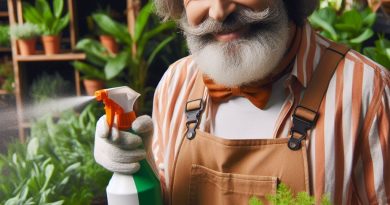Water-Efficient Plant Choices for Urban Farms
Last Updated on March 2, 2024
Introduction
Water efficiency is crucial in urban farming, and selecting water-efficient plants can greatly benefit urban farmers.
This blog post provides an overview of how choosing such plants can optimize water usage and boost productivity.
Water is a limited resource, especially in urban areas, making water efficiency a top priority for urban farmers.
By selecting water-efficient plants, farmers can reduce their water consumption and minimize wastage.
Choosing plants that require less water can not only help conserve this valuable resource but also save money on irrigation costs.
Additionally, water-efficient plants are often more resilient and can thrive even in drought or limited water conditions.
This blog post will delve into various water-efficient plant choices suitable for urban farms, providing insights on their water requirements and how to grow them effectively.
It will explore options such as succulents, native plants, and those with deep root systems.
Furthermore, the post will discuss the benefits of using mulch, which helps retain soil moisture and reduces evaporation.
It will also highlight the importance of proper watering techniques and irrigation systems in maximizing water efficiency.
Basically, this blog post aims to emphasize the significance of water efficiency in urban farming and the advantages of choosing water-efficient plants.
By implementing these strategies, urban farmers can achieve sustainable and thriving agricultural practices, even in water-scarce environments.
Read: Efficient Watering Systems for Small Gardens
Overview of Water-Efficient Plant Choices for Urban Farms
A. Definition of water-efficient plants
Water-efficient plants are species that can thrive with minimal water requirements.
They possess specific characteristics that enable them to adapt and conserve moisture effectively.
Some examples of these characteristics include deep root systems, succulent leaves, and waxy coatings.
B. Importance of considering climate and location in plant selection
When selecting plants for urban farms, it is crucial to consider the climate and location.
Plants that are native to the region or species that are well-suited to the area’s conditions are ideal choices.
Understanding the specific water needs of different plants is essential for water-efficient farming.
By choosing plants that require less water, farmers can reduce their overall water consumption.
C. How water-efficient plants can help reduce water consumption on urban farms
Water-efficient plants play a significant role in sustainable agriculture practices.
These plants not only conserve water but also contribute to the overall health and vitality of the farm.
In arid regions, where water scarcity is a concern, the selection of water-efficient plants is even more critical.
Some common water-efficient plant choices for urban farms include succulents, such as aloe vera and agave.
Succulents have fleshy leaves that store water, making them highly adapted to dry conditions.
Grasses like buffalo grass and Bermuda grass are also popular choices for water-efficient farming.
They have deep root systems that allow them to access water from lower soil layers.
In addition to specific plant characteristics, proper irrigation techniques and soil moisture management are essential.
Drip irrigation and mulching can help conserve water by delivering it directly to plant roots and reducing evaporation.
Choosing climate-appropriate plants not only saves water but also reduces the need for fertilizers and pesticides.
Native plants are often more resistant to pests and diseases, reducing the reliance on chemical treatments.
Water-efficient plants also contribute to the creation of green spaces in urban environments.
These plants can be used to beautify and enhance the aesthetic appeal of urban farms.
By incorporating water-efficient plants into urban farming practices, farmers can promote sustainability and conservation.
Reducing water consumption not only benefits the environment but also saves money and resources.
Implementing water-efficient plant choices will lead to healthier and more resilient urban farms.
In essence, water-efficient plant choices are essential for sustainable urban farming.
By selecting plants with specific characteristics and considering climate and location, farmers can conserve water.
Water-efficient plants not only reduce water consumption but also contribute to the overall health and beauty of urban farms.
Read: Watering Wisely: Seasonal Strategies
Popular Water-Efficient Plant Choices for Urban Farms
A. Succulents and Cacti
When it comes to water-efficient plants for urban farms, succulents and cacti are top choices.
These plants have unique characteristics that enable them to thrive in low-water conditions.
1. Characteristics that make succulents and cacti water-efficient
- Succulents and cacti store water in their leaves, stems, and roots, allowing them to survive extended periods without irrigation.
- They have thick, fleshy leaves that can retain water for long periods and minimize evaporation.
- Many succulents and cacti have a waxy coating on their leaves, which reduces transpiration and water loss.
- Their shallow root systems can absorb water quickly during rainfall or irrigation.
2. Popular varieties suitable for urban farming
- Aloe Vera: This succulent has medicinal properties and is easy to grow in containers.
- Jade Plant: With its beautiful foliage and low maintenance, it is an excellent choice for urban gardening.
- Prickly Pear Cactus: Known for its edible pads and fruits, it adds an exotic touch to urban farms.
- Agave: This drought-tolerant succulent comes in various sizes and dramatically enhances any urban farm.
3. Tips for cultivating succulents and cacti in an urban environment
- Ensure well-draining soil to prevent root rot and water accumulation.
- Place the plants in areas with adequate sunlight, as they need direct sunlight for optimal growth.
- Water sparingly, allowing the soil to dry out completely between waterings.
- Use pots or containers with drainage holes to prevent excess water retention.
B. Native Plant Species
Another water-efficient plant choice for urban farms is incorporating native plant species.
These plants are naturally adapted to the local environment and require minimal irrigation once established.
1. Benefits of using native plants on urban farms
- They have evolved to endure the local climate and soil conditions, reducing the need for additional water.
- Native plants support local ecosystems by attracting native wildlife, including pollinators and beneficial insects.
- They require fewer pesticides and fertilizers, promoting a more sustainable and environmentally friendly farming approach.
2. Examples of water-efficient native plants
- Yarrow: This perennial herb has delicate flowers and is known for its drought tolerance.
- California Poppy: With its vibrant orange blooms, this wildflower thrives in dry conditions.
- Manzanita: This evergreen shrub has beautiful flowers and foliage, adapting well to various soil types.
- Desert Marigold: A desert native, this annual plant produces bright yellow flowers and thrives in hot, dry climates.
3. How to incorporate native species into urban farm design
- Research native plants that are suitable for your region’s climate, soil type, and available space.
- Create native plant communities to mimic natural ecosystems, taking into consideration their water and sunlight requirements.
- Group plants with similar water needs together to make irrigation more efficient.
- Mulch around native plants to retain moisture in the soil and minimize evaporation.
C. Drought-Tolerant Herbs and Vegetables
For those looking to grow herbs and vegetables on their urban farms, opting for drought-tolerant varieties can significantly reduce water consumption.
1. Advantages of growing drought-tolerant herbs and vegetables:
- They require less irrigation, making them excellent choices for water-conscious urban farmers.
- Drought-tolerant crops often have deep root systems, enabling them to access water from deeper soil layers.
- These plants are generally more resilient to heatwaves and dry spells, ensuring a more consistent harvest.
2. Examples of water-efficient herbs and vegetables
- Rosemary: This aromatic herb thrives in dry conditions and adds flavor to various culinary dishes.
- Lavender: Known for its soothing aroma, lavender is a hardy herb that needs minimal watering.
- Kale: This leafy green is packed with nutrients and can tolerate drought, making it ideal for urban farms.
- Drought-tolerant tomatoes: Varieties like Roma or Cherry tomatoes can withstand dry conditions and still produce abundant fruits.
3. Tips for successful cultivation of drought-tolerant crops in urban settings
- Prepare the soil adequately by incorporating organic matter and improving its water-holding capacity.
- Mulch around plants to suppress weeds, retain moisture, and regulate soil temperature.
- Water deeply but infrequently to encourage deep root growth and plant resilience.
- Consider drip irrigation systems or soaker hoses to deliver water directly to the plant roots, minimizing waste.
By selecting water-efficient plants like succulents, native species, and drought-tolerant herbs and vegetables, urban farmers can conserve water while creating thriving and sustainable urban farms.
Read: Watering Wisdom: How Much is Too Much?

Find Out More: Organic Methods for Small-Scale Gardens
Considerations for Choosing Water-Efficient Plants
A. Soil type and moisture retention
- Opt for plants that thrive in well-draining soil to prevent waterlogged conditions.
- Look for species that have deep root systems, helping them access water from lower soil layers.
B. Irrigation systems and techniques
- Install drip irrigation to provide water directly to the plant roots, minimizing evaporation.
- Consider using rainwater harvesting systems to reduce reliance on municipal water sources.
C. Planting density and spacing
- Increase planting density to create a dense canopy that shades and cools the soil, reducing water loss.
- Proper plant spacing allows for sufficient air circulation, preventing diseases and promoting water conservation.
D. Companion planting for water efficiency
- Choose companion plants that have different water requirements to avoid competition for limited water resources.
- Select drought-tolerant plants as companions, as they can create microclimates that conserve moisture for other plants.
Examples of water-efficient plant options for your farm
By considering these factors, you can choose water-efficient plant options for your urban farm.
Below are some examples:
1. Succulents and Cacti
- Thrive in well-drained soil, making them perfect for water conservation.
- Adapted to arid conditions, minimizing the need for frequent watering.
2. Native Wildflowers
- Well-suited to local soil types and weather conditions, requiring less maintenance.
- Attract pollinators and add beauty to your urban farm.
3. Herbs and Medicinal Plants
- Many herbs have low water requirements and can withstand drought conditions.
- Provide culinary and medicinal benefits while conserving water.
4. Ornamental Grasses
- Offer a stunning aesthetic with minimal water needs.
- Can create a calming effect and serve as a natural windbreak for your urban farm.
5. Perennial Vegetables
- Once established, require less watering compared to annual vegetables.
- Examples include asparagus, artichokes, and rhubarb.
Remember, water-efficient plant choices are just one aspect of promoting sustainable urban farming.
Proper maintenance and careful monitoring of soil moisture levels are essential.
Prioritize organic mulching, which helps retain moisture and suppresses weed growth.
Regularly check your irrigation system for leaks and adjust watering schedules based on weather conditions.
With these strategies, you can create a thriving urban farm while minimizing water usage.
By implementing water-efficient plant choices and incorporating sustainable practices into your farming methods, you can contribute to conserving this precious resource and make your urban farm an environmentally-friendly and productive space.
Read: Garden Tool Safety: What You Need to Know
Conclusion
Water efficiency plays a crucial role in urban farming by conserving resources and reducing costs.
Urban farmers are encouraged to explore water-efficient plant choices to maximize productivity and minimize water usage.
By selecting plants that are adapted to local conditions and have low water requirements, urban farmers can optimize their yields while minimizing their ecological footprint.
In addition, it is important for urban farmers to regularly monitor soil moisture levels, implement efficient irrigation systems, and incorporate mulching techniques to retain soil moisture.
These practices will further enhance water efficiency in their farming operations.
For those looking to delve deeper into the topic, there are various resources available, such as online forums, agricultural extension services, and publications dedicated to water-efficient farming practices.
These resources can provide further guidance and inspiration for urban farmers to adopt sustainable water practices in their operations.
By incorporating water-efficient plant choices and adopting sustainable water practices, urban farmers can contribute to the conservation of water resources in their communities while ensuring the long-term viability of their farming endeavors.


